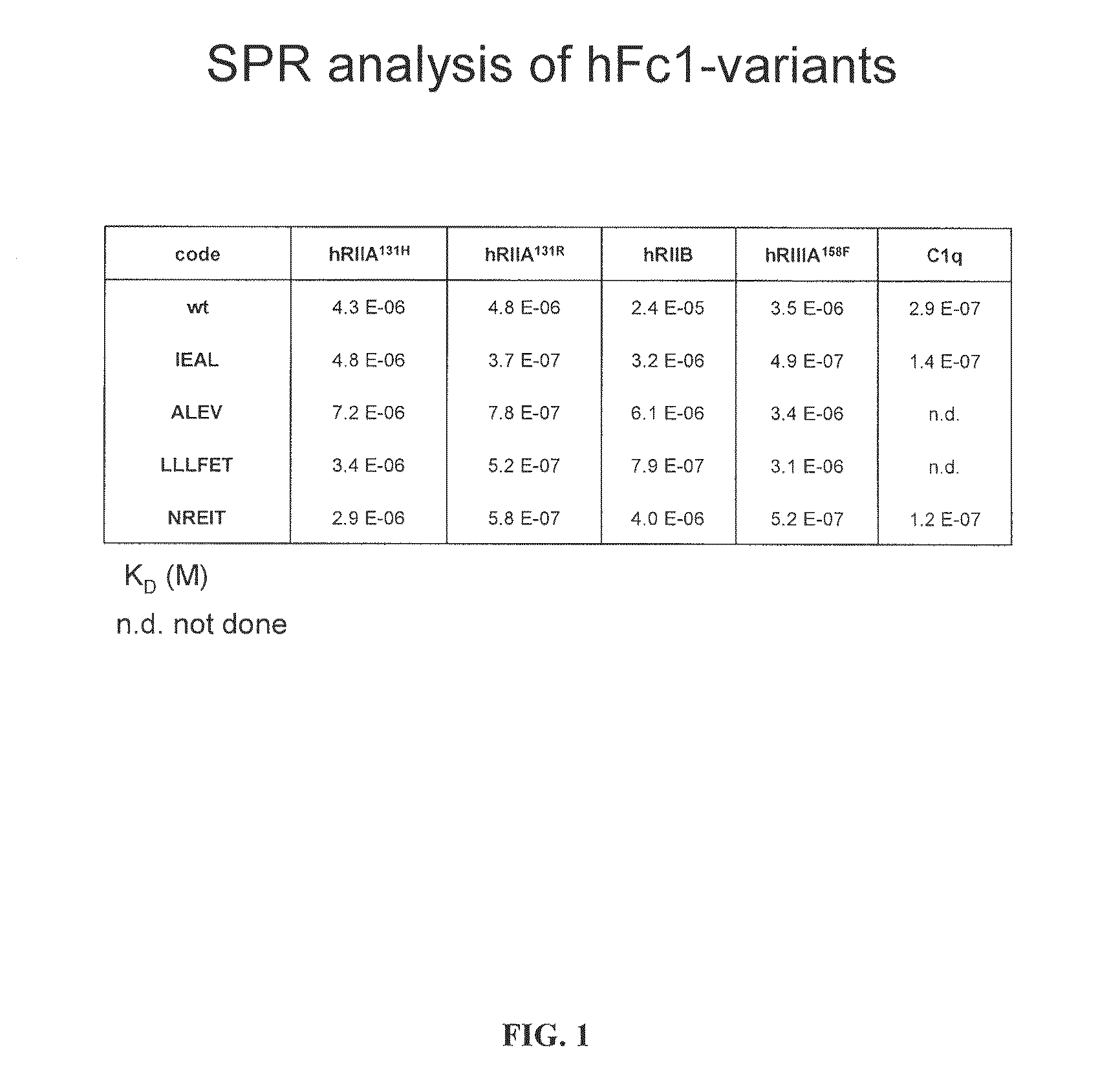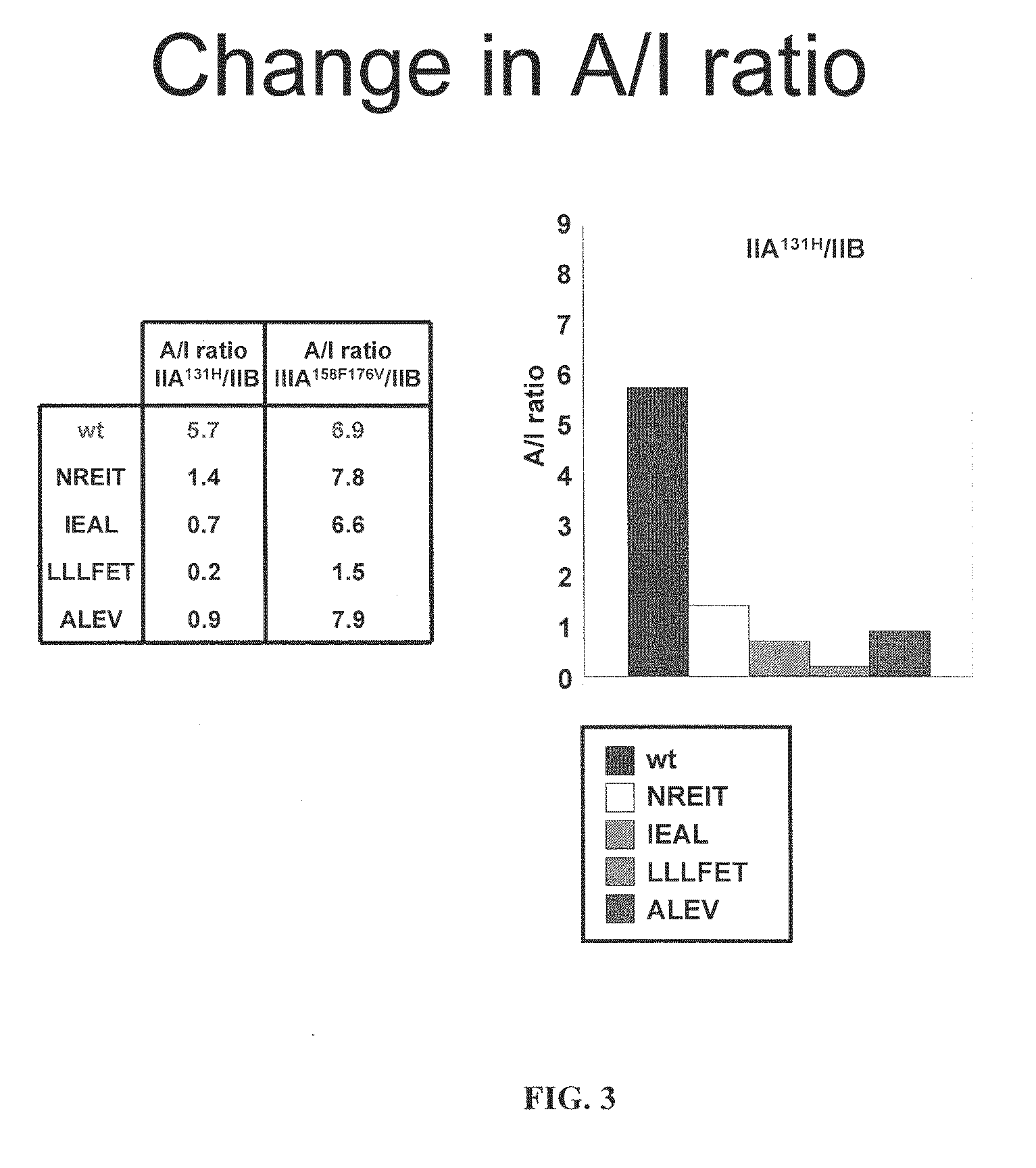Fc mutants
- Summary
- Abstract
- Description
- Claims
- Application Information
AI Technical Summary
Benefits of technology
Problems solved by technology
Method used
Image
Examples
example 1
FC Variant Selection
[0120]To identify IgG1 Fc variants with preferential binding affinity to the inhibitory FcRIIB receptor, a library of Fc variants was constructed according to published methods. (Boder et al, Yeast surface display for screening combinatorial polypeptide libraries, Nature Biotechnology, 15:553-557, April 1997; Chao et al, Isolating and engineering human antibodies using yeast surface display, Nature Protocols, 1:755-768, 2006).
[0121]Library Construction.
[0122]Libraries were constructed by homologous recombination of a mutated hIgG1 heavy-chain constant-region insert into the pYD1 (Invitrogen) yeast-secretion vector template according to previously published methods (Chao et al, Nat Protoc 1:755-768 (2006)). The hIgG1 CH1 to CH3 constant domain gene inserts were transformed with digested template vector by electroporation into the yeast strain EBY100 (Invitrogen).
[0123]Library Construction: Preparation of Digested Template Vector and Mutagenic Gene Inserts.
[0124]Th...
example 2
Mutants with Enhanced Affinity for hRIIB
[0151]Fc variants were obtained from the constructs of Example 1 that show enhanced binding to constructed FcγRIIB over FcγRIIA131H, FcγRIIA131R and FcγRIIIA158F. A number of promising Fc variants with optimized properties were obtained from the FcγRIIA, FcγRIIIA and FcγRIIB screen. Table 1 provides Fc variants that bind more tightly to FcγRIIIA, and thus are candidates for improving the effector function of antibodies and Fc fusions. These include a number of variants that comprise mutations at 215, 326, 359, and 396; 247, 252, 266, 278, 302, and 354; and 211, 243, 326, and 399. For example, variant “ZEAL” (ASTKGPSVFPLAPSSKSTSGGTAALGCLVKDYFPEPVTVSWNSGALTSGVHTFPAVLQS SGLYSLSSVVTVPSSSLGTQTYICNVNHKPSNTKVDKRIEPKSCDKTHTCPPCPAPELLG GPSVFLFPPKPKDTLMISRTPEVTCVVVDVSHEDPEVKFNWYVDGVEVHNAKTKPREE QYNSTYRVVSVLTVLHQDWLNGKEYKCKVSNEALPAPIEKTISKAKGQPREPQVYTLPP SRDELAKNQVSLTCLVKGFYPSDIAVEWESNGQPENNYKTTPLVLDSDGSFFLYSKLTV DKSRWQQGNVFSCSVMHEALHNHYTQKSLSLSPGK, SEQ ...
example 3
[0156]The present invention provides a mechanistic basis for the observed variation in IgG subclass activity in both active and passive vaccination and in the variable pathogenicity of the IgG subclasses in autoimmune conditions. The selective FcγR binding affinities of the IgG subclasses, and not their ability to fix complement, is predictive of the in vivo activity for cytotoxic antibodies in models of tumor clearance, platelet and B cell depletion (Uchida et al., J Exp Med 199, 1659-69. (2004); Clynes and Ravetch (1995); Clynes (1998); Samuelsson (2001)). Similarly, the biological consequences of modifications to IgG antibodies are, in turn, dependent on their effects on specific FcR binding affinities that result in changes to the ratio of activation to inhibitory receptor affinities. These considerations will be significant factors in the design of both antibody-based immunotherapeutics and active vaccination protocols to insure either the selective engineering of IgG Fc domain...
PUM
| Property | Measurement | Unit |
|---|---|---|
| Volume | aaaaa | aaaaa |
Abstract
Description
Claims
Application Information
 Login to View More
Login to View More - R&D
- Intellectual Property
- Life Sciences
- Materials
- Tech Scout
- Unparalleled Data Quality
- Higher Quality Content
- 60% Fewer Hallucinations
Browse by: Latest US Patents, China's latest patents, Technical Efficacy Thesaurus, Application Domain, Technology Topic, Popular Technical Reports.
© 2025 PatSnap. All rights reserved.Legal|Privacy policy|Modern Slavery Act Transparency Statement|Sitemap|About US| Contact US: help@patsnap.com



